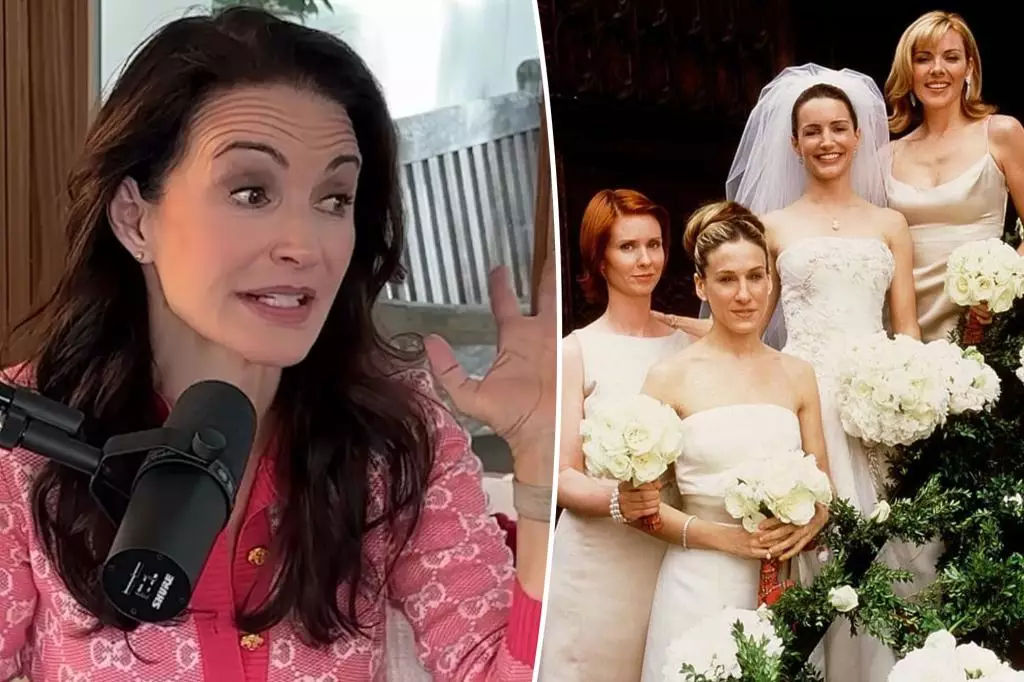The enduring legacy of “Sex and the City,” a cultural touchstone that resonates even years after its debut, brings to light not only its fashionable allure but also the complexities of its behind-the-scenes relationships. Recently, Kristin Davis, who portrayed the refined Charlotte York, shed light on a remarkable wardrobe tension involving her co-star Sarah Jessica Parker. This dispute occurred during the filming of a pivotal episode centered around Charlotte’s wedding to Trey MacDougal, leading to queries about how wardrobe choices can ignite discord among cast members.
Davis indicated that Parker, who embraced the lead role of Carrie Bradshaw, might still harbor resentment regarding the beige bridesmaid dress she was required to wear during the wedding scene. During a candid conversation on the “Are you a Charlotte?” podcast with showrunner Michael Patrick King, Davis recounted how Parker was decidedly displeased with the color choice. Davis’s assertion that Parker is “still mad” underscores the significance of personal expression through character outfits, especially in a series renowned for its fashion.
Diving deeper, the incident highlights the genuine reactions that can arise within a collaborative creative environment. Parker, who transformed into an icon through her role, felt so strongly about the color that she reportedly went to extreme lengths to modify the Vera Wang dress in question. King reiterated this sentiment, revealing that Parker even resorted to cutting the dress and introducing tartan patterns in a bid to express her individuality—a perfect representation of her character’s spirited nature.
What becomes evident through this wardrobe dispute is the multifaceted relationship between character personas and actor identities. As Davis pointed out, Parker confided in her regarding her feelings about the outfit, asking, “I don’t understand…” To which Davis responded, reinforcing the appropriateness of the beige attire, given the context of the wedding and the character of Charlotte who represented sophistication and tradition. This moment captures a clash between personal aesthetics and character alignment, provoking discussions about how costume choices reflect larger thematic elements in storytelling.
Wardrobe controversies are not simply relegated to trivial disputes; they can encapsulate larger issues of representation, identity, and character authenticity in television. The beige dresses worn by various characters in the episode highlighted their connection and role as part of Charlotte’s life, making Parker’s pushback an instinctive projection of her character’s desires for individuality amidst the group’s collective representation.
The conversation with King further revealed how future episodes transitioned from this discord towards a more collaborative wardrobe approach, particularly in Carrie’s iconic wedding to Mr. Big. Davis noted that the bridal designs took on a more distinct personal flair rather than adhering to a singular style—something evident in both Carrie’s Vivienne Westwood gown and her girls’ varied looks.
This progression signifies not only character development but also a maturation in the narrative as it explored more profound themes of love and identity. While earlier seasons emphasized uniformity in friendship—exemplified through the matched bridesmaids’ dresses—the later seasons, particularly in the film, showcased the individuality of each character, hinting at evolving interpersonal dynamics.
The fashion choices within “Sex and the City” serve an essential purpose beyond mere aesthetics; they reflect the intricacies of female friendships and the complexities engendered by personal and group identities. Conflict over wardrobe choices mirrors broader themes of self-expression and conformity. As the characters navigate love and friendship, their fashion becomes a dialogue within the narrative.
The details surrounding the wardrobe dispute not only provide a glimpse into the atmosphere on set but also offer a nuanced understanding of how those involved navigated their roles both personally and creatively. Ultimately, this incident reinforces that behind the glamorous façade of television production—a world where wardrobe can define a character—lies the essence of human emotions and relationships. The interplay of personal preferences and character duties remains a powerful undercurrent in the storytelling process, demonstrating that even in a well-loved series, tensions can arise and transcend into iconic moments of television history.

